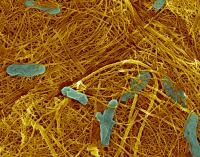Dec 10 2007
Two engineers at the University of California, Riverside are part of a binational team that has found semiconducting nanotubes produced by living bacteria – a discovery that could help in the creation of a new generation of nanoelectronic devices.
 Shewanella bacteria (shown in blue) forming nanotubes.
Shewanella bacteria (shown in blue) forming nanotubes.
The research team believes this is the first time nanotubes have been shown to be produced by biological rather than chemical means. It opens the door to the possibility of cheaper and more environmentally friendly manufacture of electronic materials.
Study results appear in today's issue of the early edition of the Proceedings of the National Academy of Sciences.
The team, including Nosang V. Myung, associate professor of chemical and environmental engineering in the Bourns College of Engineering, and his postdoctoral researcher Bongyoung Yoo, found the bacterium Shewanella facilitates the formation of arsenic-sulfide nanotubes that have unique physical and chemical properties not produced by chemical agents.
“We have shown that a jar with a bug in it can create potentially useful nanostructures,” Myung said. “Nanotubes are of particular interest in materials science because the useful properties of a substance can be finely tuned according to the diameter and the thickness of the tubes.”
The whole realm of electronic devices which power our world, from computers to solar cells, today depend on chemical manufacturing processes which use tremendous energy, and leave behind toxic metals and chemicals. Myung said a growing movement in science and engineering is looking for ways to produce semiconductors in more ecologically friendly ways.
Two members of the research team, Hor Gil Hur and Ji-Hoon Lee from Gwangju Institute of Science and Technology (GIST), Korea, first discovered something unexpected happening when they attempted to remediate arsenic contamination using the metal-reducing bacterium Shewanella. Myung, who specializes in electro-chemical material synthesis and device fabrication, was able to characterize the resulting nano-material.
The photoactive arsenic-sulfide nanotubes produced by the bacteria behave as metals with electrical and photoconductive properties. The researchers report that these properties may also provide novel functionality for the next generation of semiconductors in nano- and opto-electronic devices.
In a process that is not yet fully understood, the Shewanella bacterium secretes polysacarides that seem to produce the template for the arsenic sulfide nanotubes, Myung explained. The practical significance of this technique would be much greater if a bacterial species were identified that could produce nanotubes of cadmium sulfide or other superior semiconductor materials, he added.
“This is just a first step that points the way to future investigation,” he said. “Each species of Shewanella might have individual implications for manufacturing properties.”